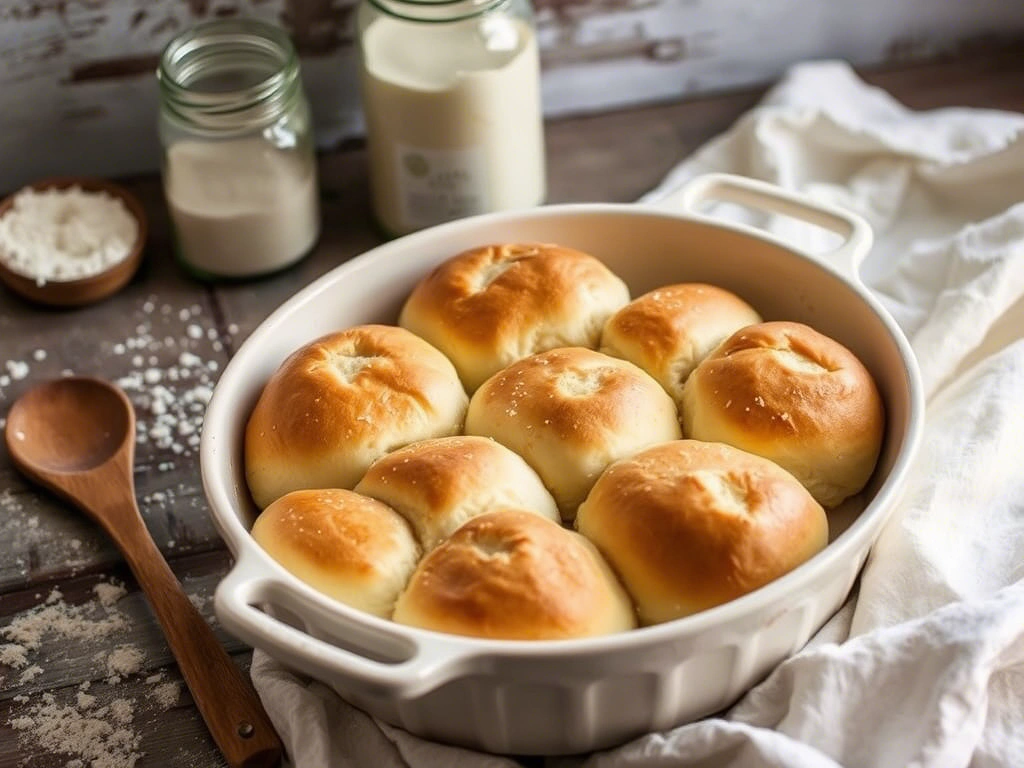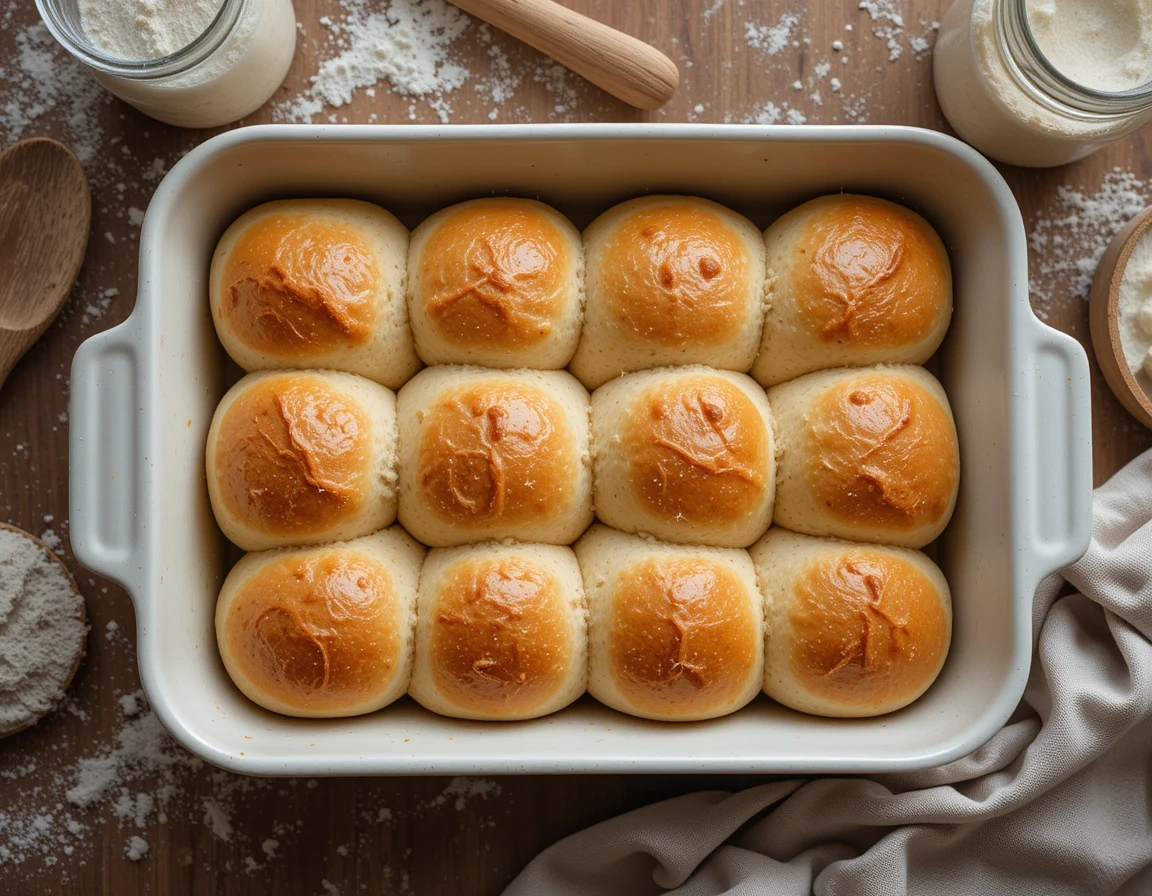I still remember the first time I made sourdough rolls at home—the dough was sticky, the wait felt endless, but the moment those golden, fluffy rolls came out of the oven, it was pure magic. The tangy aroma, the soft crumb, and the buttery finish transformed my kitchen into a bakery. If you’ve ever wanted to master homemade sourdough rolls that are both soft and crusty, this recipe will guide you through every step, from starter to oven.”,
Table of Contents
The Ultimate Guide to Perfecting Your Homemade Sourdough Rolls
Sourdough bread is made using a traditional method that harnesses the natural wild yeast and lactobacilli bacteria to ferment the dough. Sourdough bread is made using a traditional method that harnesses the natural wild yeast and lactobacilli bacteria to ferment the dough. This fermentation process not only imparts a unique tangy flavor to the bread but also enhances its texture and shelf life. Sourdough is characterized by its chewy crust, soft and airy interior, and complex flavor profile.
The key to successful sourdough lies in understanding the symbiotic relationship between yeast and bacteria, as well as the fermentation process that occurs over an extended period. Sourdough starters are the essential foundation of sourdough baking. They consist of a blend of flour and water that captures natural yeast and bacteria from the surrounding environment.Sourdough starters are the essential foundation of sourdough baking. They consist of a blend of flour and water that captures natural yeast and bacteria from the surrounding environment.
This living culture needs to be fed regularly to maintain its activity and ensure successful bread-making. The starter provides leavening for the dough, giving it rise and structure. Understanding the nuances of sourdough starters and fermentation is crucial for achieving the perfect sourdough rolls.
Choosing the Right Ingredients for Sourdough Rolls
The quality of your sourdough rolls heavily depends on the ingredients used. Opting for high-quality flour is essential, as it forms the base of the dough and contributes to its texture and flavor. Whole grain flours, such as whole wheat or rye, can add depth to the flavor profile of the rolls.
Additionally, water quality is crucial, as chlorine in tap water can inhibit the growth of wild yeast and bacteria in the starter. Using filtered or bottled water is recommended for best results. Salt is another crucial ingredient in sourdough rolls, as it not only enhances the flavor but also regulates the fermentation process.
It strengthens the gluten structure, controls yeast activity, and adds complexity to the taste. When it comes to enriching the flavor, consider incorporating additional ingredients such as honey, herbs, seeds, or even dried fruits. These elements can elevate the taste profile of your rolls and add a unique twist to your sourdough baking.
Step-by-Step Instructions for Making Sourdough Starter
Creating a sourdough starter from scratch is a fundamental step in mastering sourdough baking. To begin, mix equal parts of flour and water in a glass or plastic container. The mixture should resemble a thick pancake batter.
Place a lid or cloth over the container in a loose manner to allow for the colonization of the mixture by wild yeast and bacteria from the surrounding environment. Over the next few days, feed the starter by discarding half of it and adding fresh flour and water at regular intervals. As the starter matures, it will develop a distinct tangy aroma and bubbles indicating its activity.
This process typically takes around 5-7 days, depending on environmental factors such as temperature and humidity. Once your starter is active and bubbly, it is ready to be used in sourdough recipes. Regular feeding and maintenance are essential to keep the starter healthy and active for future baking endeavors.
Tips for Perfecting the Fermentation Process
| Tip | Description |
|---|---|
| Use Quality Ingredients | Begin with fresh, top-notch ingredients to achieve optimal fermentation outcomes. |
| Maintain Proper Temperature | Keep the fermentation vessel at the recommended temperature for the specific fermentation process. |
| Monitor pH Levels | Regularly check and adjust the pH levels to create the ideal environment for fermentation. |
| Control Oxygen Exposure | Avoid excessive exposure to oxygen, as it can negatively impact the fermentation process. |
| Follow Proper Timing | Adhere to the recommended fermentation times for the specific type of food or beverage. |
Fermentation is a critical stage in sourdough baking that greatly influences the flavor and texture of the rolls. Controlling the temperature during fermentation is crucial for achieving consistent results. Warmer temperatures accelerate fermentation, while cooler temperatures slow it down.
Finding the ideal temperature range for your sourdough environment is key to achieving the desired flavor profile. Additionally, understanding the signs of fermentation progression is essential. Look for an increase in volume, visible bubbles on the surface, and a pleasant tangy aroma to gauge the readiness of the dough for shaping.
Experimenting with different fermentation times can also help you tailor the flavor and texture of your sourdough rolls to your preference.

Key Takeaways
- Understanding the basics of sourdough is essential for perfecting homemade rolls.
- Choosing the right ingredients, such as high-quality flour and water, is crucial for successful sourdough rolls.
- Following step-by-step instructions for making sourdough starter is key to achieving the perfect texture and flavor.
- Tips for perfecting the fermentation process, including temperature and timing, are important for successful sourdough rolls.
- Shaping and baking techniques are essential for achieving the perfect texture and crust on sourdough rolls.
Shaping and Baking Sourdough Rolls
Once your sourdough dough has undergone fermentation, it’s time to shape and bake your rolls. Gently deflate the dough to release excess gas and divide it into individual portions for shaping. Traditional shaping methods include forming round boules or elongated batards, but feel free to experiment with different shapes to add visual appeal to your rolls.
Preheat your oven and baking vessel to ensure a hot environment for optimal oven spring—the rapid rise of dough during initial baking that creates an airy crumb structure. Slashing the tops of your rolls just before baking allows them to expand without tearing during this process. Bake your rolls until they develop a golden-brown crust and sound hollow when tapped on the bottom.
Allow them to cool before indulging in their delightful aroma and flavor.
Troubleshooting Common Sourdough Roll Issues
Dense Crumb: Causes and Solutions
Dense crumb may be caused by overproofing or inadequate gluten development. Adjusting fermentation times and incorporating stretch-and-fold techniques during dough preparation can help address these issues.
Lack of Rise: Identifying the Problem
If your rolls lack rise, it could be due to weak starter activity or inadequate proofing. Reviving your starter or providing a warmer proofing environment can help rectify this problem.
Troubleshooting Tips
By understanding the causes of common sourdough baking issues, you can take steps to improve your skills and achieve better results.
Creative Variations and Flavor Additions for Sourdough Rolls
While traditional sourdough rolls are delightful on their own, there are endless opportunities for creative variations and flavor additions. Experiment with incorporating ingredients such as olives, sun-dried tomatoes, cheese, or aromatic herbs into your dough to create unique flavor profiles. You can also explore different shaping techniques or scoring patterns to add visual interest to your rolls.
Furthermore, consider exploring sweet variations of rolls by incorporating ingredients like cinnamon, raisins, or chocolate chips for a delightful twist on this classic bread. Embracing creativity in your sourdough baking allows you to tailor your rolls to suit various occasions and preferences, making each batch a unique culinary creation. In conclusion, mastering the art of homemade sourdough rolls requires a deep understanding of sourdough basics, ingredient selection, starter cultivation, fermentation control, shaping techniques, troubleshooting methods, and creative exploration of flavors.
By honing these skills and techniques, you can elevate your sourdough baking prowess and delight in the satisfaction of creating delectable, artisanal sourdough rolls from scratch.
FAQs
What is sourdough?
Sourdough bread is crafted through the natural fermentation of dough using wild yeast and lactobacilli bacteria. This unique process results in the distinctive tangy flavor and chewy texture that sourdough is known for.
What are the basic ingredients for making sourdough rolls?
To create delicious sourdough rolls, you’ll need just a few simple ingredients: flour, water, salt, and a sourdough starter. This starter is a blend of flour and water that has been naturally fermented with wild yeast and lactobacilli bacteria.
How do you make a sourdough starter?
Create a sourdough starter by combining equal amounts of flour and water in a jar and allowing it to ferment at room temperature, while regularly feeding it with additional flour and water until it becomes bubbly and active. This process usually takes about 5-7 days.
How can you improve the fermentation process when making sourdough rolls? Here are some tips for perfecting your technique.
Some tips for perfecting the fermentation process include maintaining the right temperature for fermentation, using a mature and active sourdough starter, and allowing the dough to ferment for the appropriate amount of time to develop flavor.
How do you shape and bake sourdough rolls?
To shape sourdough rolls, divide the dough into individual portions, shape them into rounds, and let them proof before baking. Baking sourdough rolls typically involves preheating the oven, scoring the rolls, and baking them at a high temperature to achieve a crispy crust.
What are some common issues when making sourdough rolls and how can they be troubleshooted?
Common issues when making rolls include dense texture, lack of rise, and overly sour flavor. These issues can be troubleshooted by adjusting the fermentation time, using a different flour-to-water ratio, or experimenting with different shaping and baking techniques.
What are some creative variations and flavor additions for sourdough rolls?
Creative variations and flavor additions for sourdough rolls include adding herbs, cheese, olives, or seeds to the dough, or experimenting with different types of flour such as whole wheat or rye to create unique flavors and textures.
